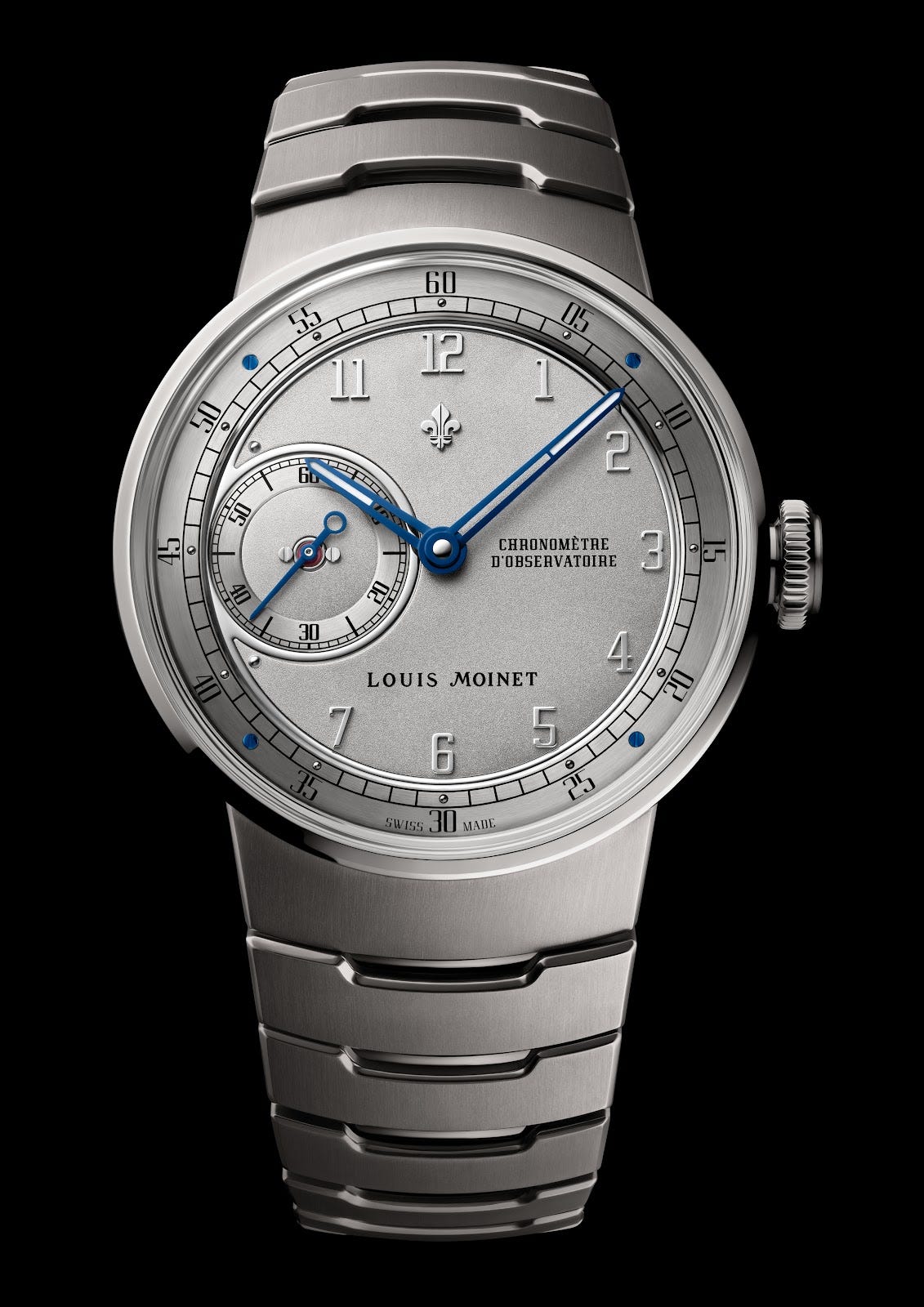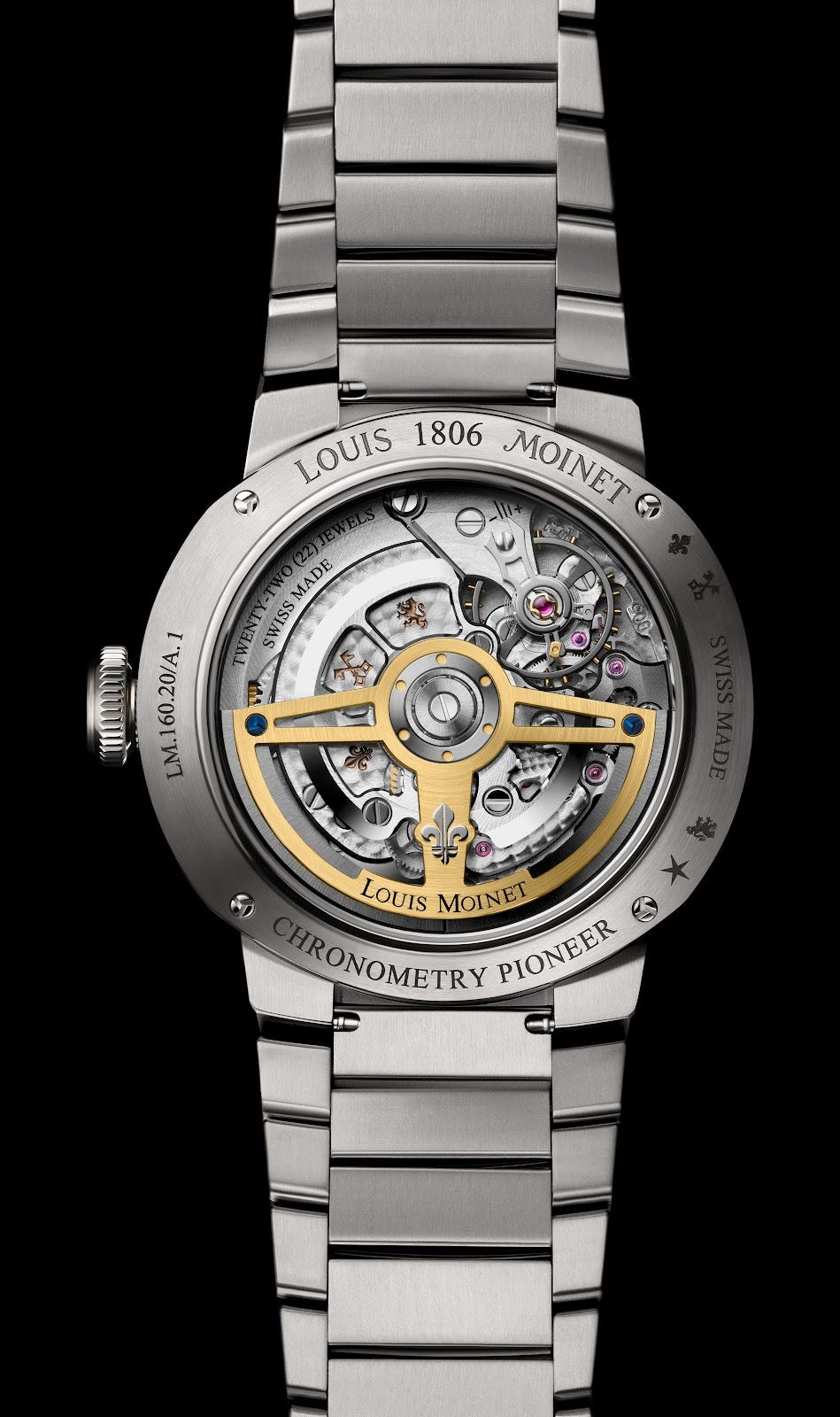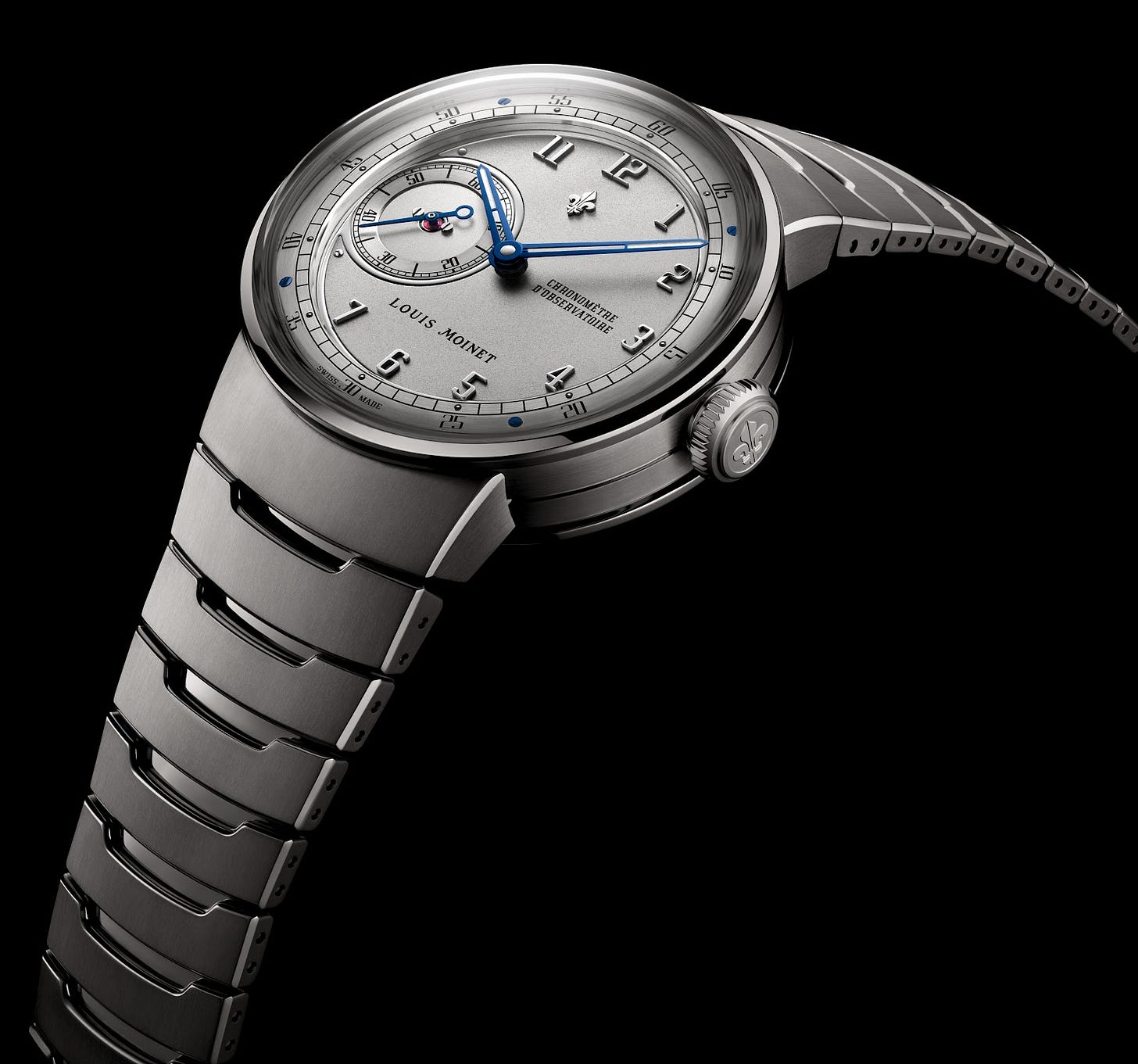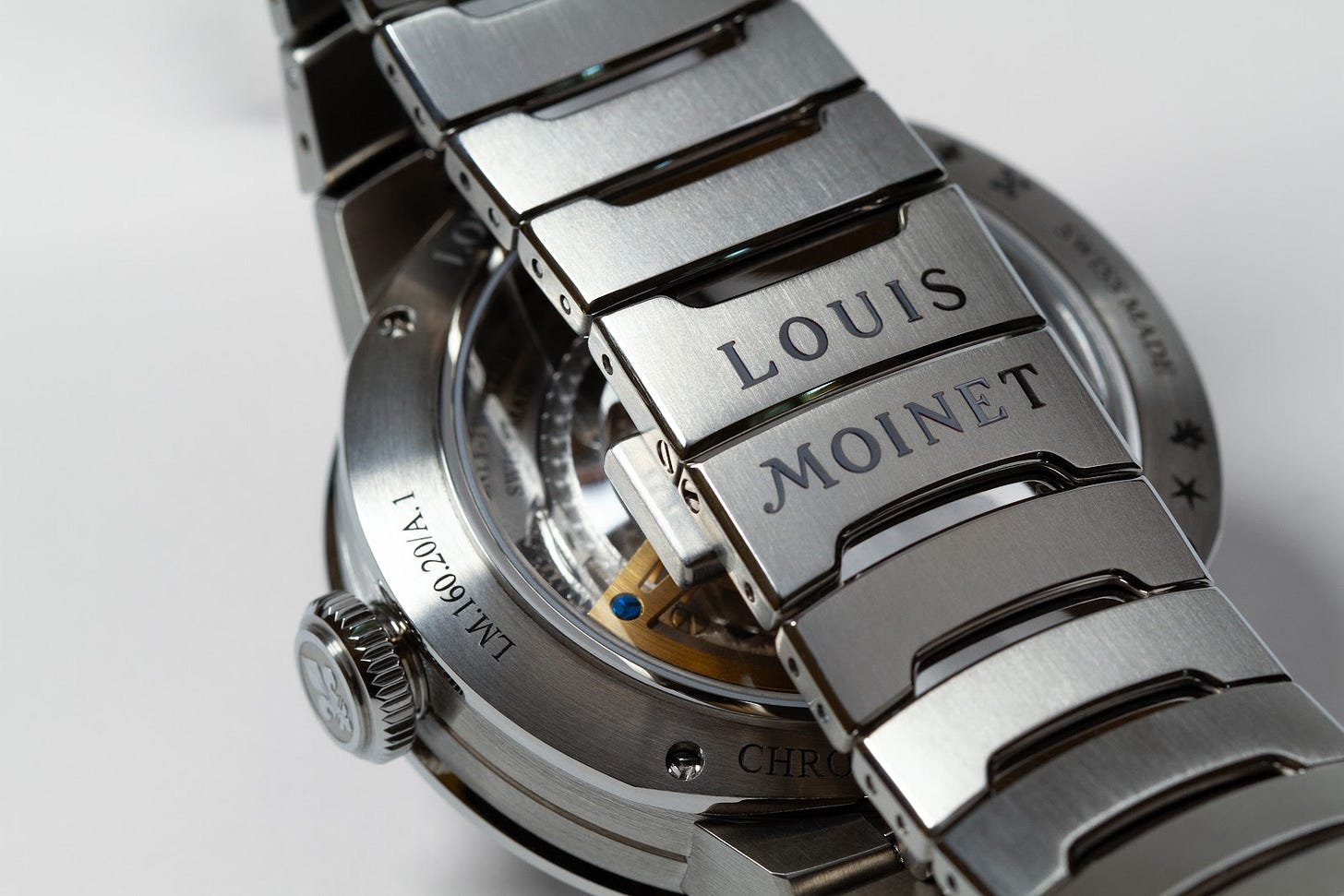Louis Moinet 1806 Chronomètre d’Observatoire Review: Observatory Certification in 2025
The Emperor’s New Chronometer: Or, how to charge CHF 18,900 for certification from an observatory that stopped caring about mechanical timekeeping when Nixon was president.
Louis Moinet unveiled the 1806 Chronomètre d’Observatoire at Geneva Watch Days 2025: a titanium integrated bracelet watch priced at CHF 18,900, powered by caliber LM1806, and certified by the Geneva Astronomical Observatory after fifteen days of testing. The brand positions this time-only piece as accessible luxury for “modern explorers.” What follows is one writer’s meditation on what that actually means.
Behold the magnificent contradiction of the Louis Moinet 1806 Chronomètre d’Observatoire: a brand that claims lineage from the inventor of the chronograph—that Louis Moinet fellow who actually did invent something useful in 1816—now presents us with a time-only watch that costs as much as a luxury car down payment yet accomplishes less than the phone in your pocket. But ah! It bears the sacred imprimatur of “observatory certification,” which sounds frightfully important until one discovers that observatory competitions ended when the Swiss realized that Seiko was embarrassing them at their own game.
The Louis Moinet 1806: Titanium, Gold, and Theatre
To grasp this temporal comedy, one must appreciate how Louis Moinet has pivoted from its previous incarnation as purveyor of tourbillons encased in actual meteorites (because nothing says “practical timekeeping” like space rocks) to chasing the titanium-bracelet zeitgeist at Geneva Watch Days 2025. The brand has discovered what Vacheron Constantin and Audemars Piguet learned decades ago: wealthy men will pay astronomical sums for integrated bracelets that make their wrists look vaguely athletic. At CHF 18,900, the 1806 positions itself as the “accessible” Louis Moinet—rather like offering a “budget” Hermès bag made from merely excellent leather instead of unicorn hide.
The marketing department breathlessly informs us that the Geneva Astronomical Observatory has blessed this titanium confection with its celestial approval after “fifteen days of trials” involving “different positions and subjected to various temperature variations.” One imagines stern Swiss technicians rotating the watch with Germanic precision while adjusting thermostats, all to achieve what your smartphone accomplishes by accident while receiving Instagram notifications. But why let practical reality intrude upon such delicious theatre? The same observatory that once served maritime navigation—when knowing the time to the second meant the difference between reaching Tahiti or becoming shark food—now certifies luxury accessories for men who navigate primarily between their Tesla and the golf club.
Here lies the exquisite ritual that separates the merely rich from the truly sophisticated: the automatic rotor, “openworked and gold-plated with fleur-de-lys applique,” spinning visibly beneath a see-through caseback like some mechanical prayer wheel. The wearer purchases the right to know that somewhere, in microscopic darkness, ruby jewels and geneva stripes collaborate in an elaborate dance that accomplishes what a $20 Casio does with fewer moving parts and superior accuracy. It is rather like hiring a full orchestra to hum while you check your email—magnificently unnecessary and all the more precious for its futility.
The brand narrative promises that the 1806 serves “modern explorers,” which presumably refers to the intrepid souls who brave the perilous journey from boardroom to wine bar. The “Bridge Project” bracelet—one can practically hear the marketing meeting where someone decided that calling it the “Expensive Metal Links Project” lacked poetry—promises ergonomic excellence for wrists that will predominantly explore the treacherous terrain of steering wheels and conference tables. One wonders if Napoleon’s 1806 clock commission was similarly marketed as being ideal for “contemporary emperors seeking to conquer new territories”—by which they meant Belgium.
Observatory Certification in the Digital Age
The brand’s historical claims deserve a moment’s examination, if only for their audacious selectivity. Louis Moinet did indeed create the world’s first chronograph in 1816, achieving the rather remarkable feat of 216,000 vibrations per hour for astronomical observation. This represents genuine horological achievement—the man was measuring star transits when most people thought the universe revolved around their village church. However, the brand’s appropriation of the “Napoleon Clock” commission as inspiration for a contemporary sports watch requires the sort of creative interpretation typically reserved for abstract art criticism. The authentic craft elements—hand-finishing, Côtes de Genève, the LM1806’s genuine 48-hour power reserve—deserve recognition independent of these mythological embellishments.
What the 1806 Actually Delivers
What the 1806 actually provides is membership in that most exclusive club: people who pay premium prices for inferior performance while feeling superior about it. The psychological function operates flawlessly—the wearer experiences the profound satisfaction of mechanical complexity while their phone automatically adjusts for daylight saving time. It is precision theater, performed for an audience of one’s own wrist. The “observatory certification” serves as a luxury tax on anxiety, transforming the existential terror of temporal uncertainty into the comfort of Swiss-approved accuracy that is still less reliable than atomic clock synchronization.
This magnificent absurdity—mechanical precision in the age of digital supremacy—reveals the 1806’s true genius. Every tick of its 28,800 vph frequency becomes an act of willful anachronism, like insisting on traveling by horse-drawn carriage because automobiles lack soul. The observatory certification functions as horological theatre, a performance of precision for connoisseurs who understand that true luxury lies not in superior functionality but in beautiful, expensive inadequacy.
And so the 1806 succeeds brilliantly as what it actually is: a very pretty, very expensive meditation on the persistence of human vanity. It transforms the simple act of checking the time into an elaborate ritual involving titanium, gold plating, and the blessing of Swiss observatories that stopped being relevant when quartz crystals learned to vibrate more accurately than all the jeweled bearings in Geneva. Magnificent!
Author’s Note
What follows is one writer’s interpretation—personal, partial, and unapologetically subjective. It is cultural critique, not corporate verdict; a reflection on symbols, not a judgment on the brand itself.







